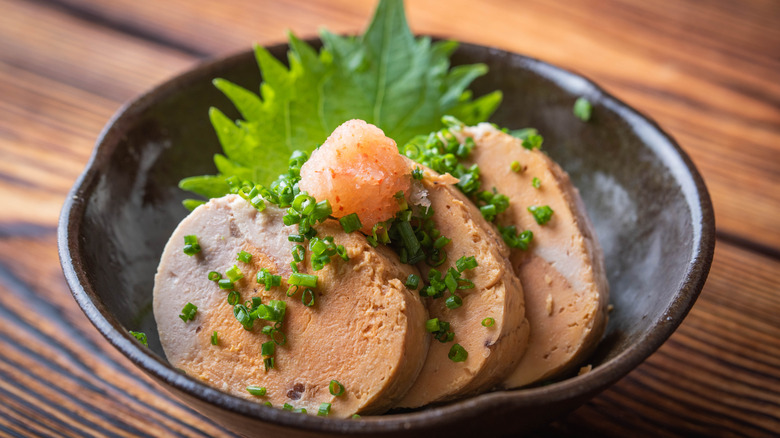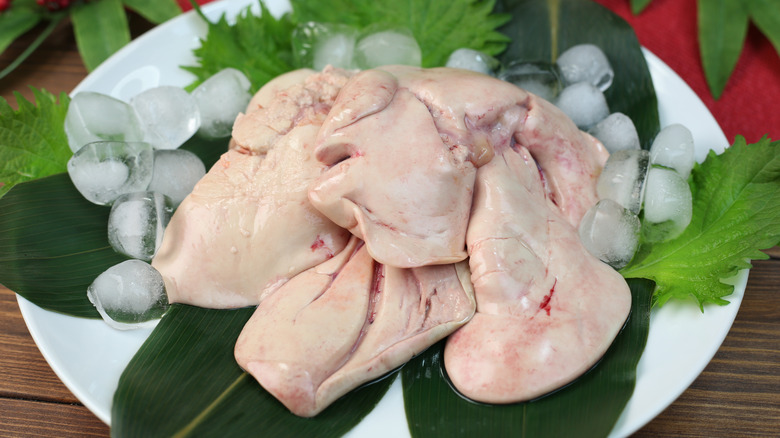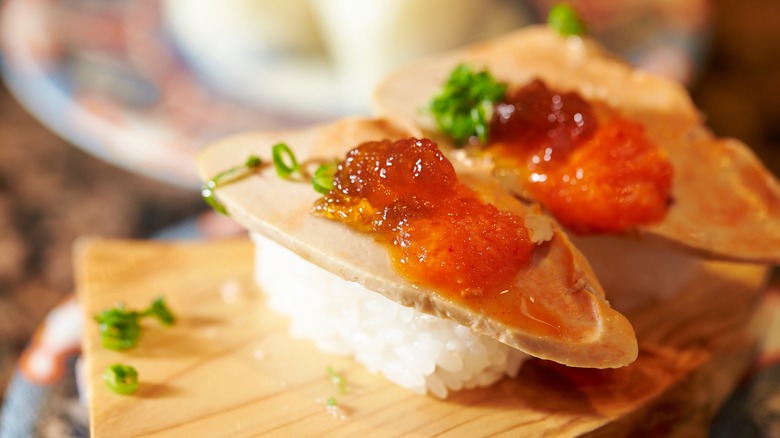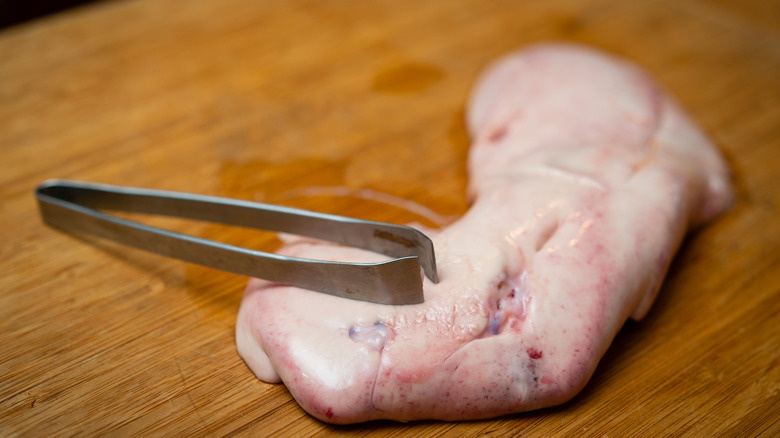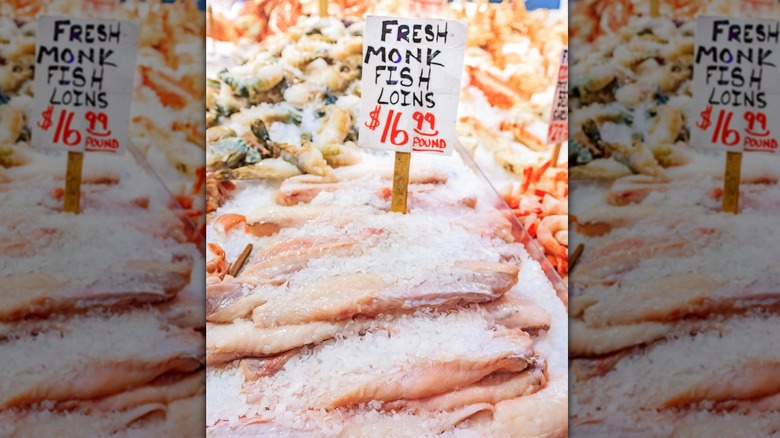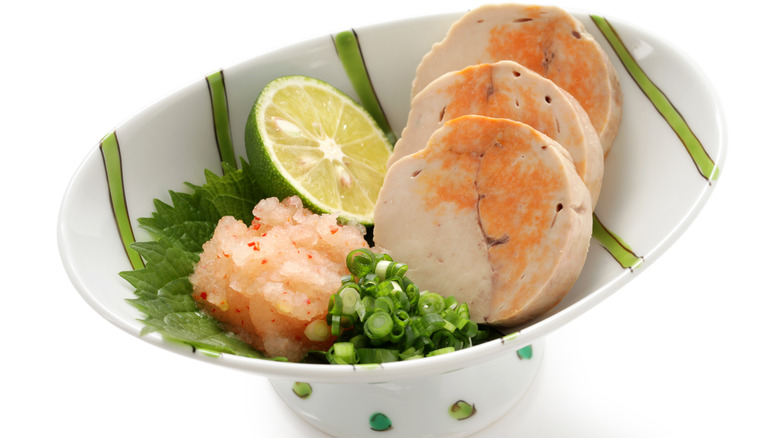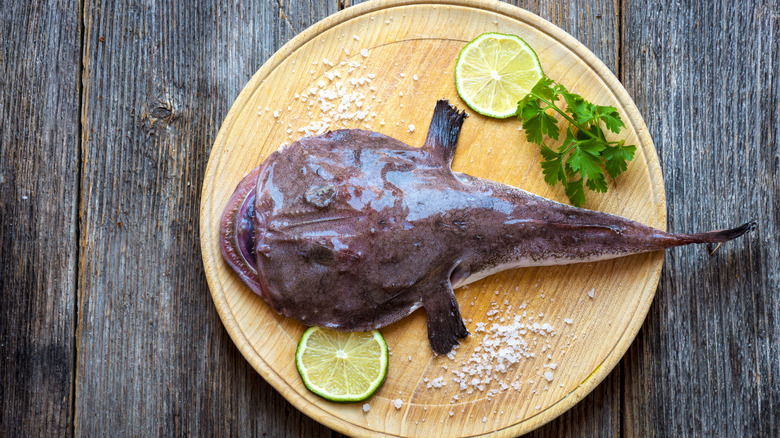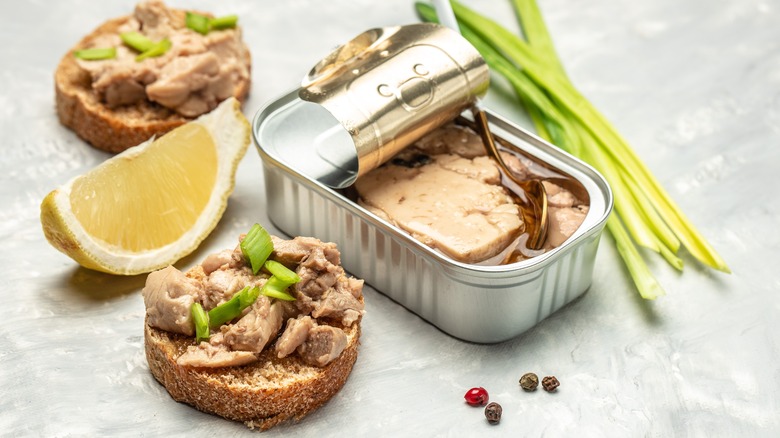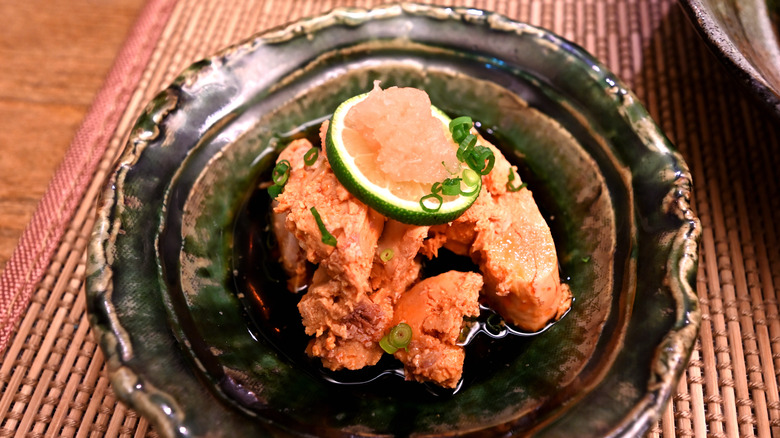What Is Ankimo And What Does It Taste Like?
Cooking with offal, which uses a variety of animal organs, is a widespread practice among chefs. The popularity of nose-to-tail cooking has sparked renewed interest in using all parts of fish (nose-to-scale, maybe?) — and the liver of these finned creatures is not spared the chef's knife. You may be familiar with duck pâté, the creamy, indulgent spread made from duck liver. But what about ankimo? Also known as monkfish liver, this Japanese delicacy is making waves in the culinary world, with Ludo Lefebvre calling it the new foie gras way back in 2015.
Before monkfish liver was celebrated by a handful of chefs dipping into Asian cuisine, it was first and foremost a revered dish by Japanese chefs, prized for its rich flavor, velvety texture, and cultural significance. It's a testament to the Japanese culinary tradition of utilizing every part of the fish and transforming it into something exquisite and delicious.
But ankimo is no peasant dish that just anyone can prepare and serve. There is a long history and tradition behind monkfish liver; its preparation requires training, skill, and a deep understanding of the subtleties of Japanese cuisine. Before you rush out to a fishmonger in search of your next culinary experiment, here's what you need to know.
What is ankimo?
Ankimo is the liver of the monkfish (it's also known as monkfish liver or anglerfish liver). It's difficult to imagine such an elegant ingredient coming from such a hideous fish, but ankimo is considered a delicacy in Japanese cuisine, prized for its subtle flavor and luxurious texture. Ankimo is often served chilled and thinly sliced, a simple preparation that focuses all attention on its beautifully light taste; it has a long history in Japanese cuisine and is a culturally significant ingredient.
Some believe that the consumption of monkfish liver was pioneered by Japanese fisherman who could not afford to throw away any of their catch, and the 6-inch, 1-pound organ was no exception. Ankimo is generally served in Japan only during winter when it is at its peak — these days, however, many chefs outside of Asia access it out of season. It's featured in traditional kaiseki (multi-course) meals and is prized for its unique flavor and texture. As a symbol of wealth, ankimo comes with a price tag to match its rarity. In modern Japanese history, monkfish liver is still mostly only available in upscale restaurants and is consumed on special occasions.
In addition to its celebration of prosperity and abundance, the preparation of ankimo acknowledges and celebrates culinary craftsmanship. The precision required to properly prepare ankimo is a testament to the prowess of the chef behind the knife. The simplest, most common preparations offer very few shortcuts, so any chef who addresses monkfish liver must be up to the task.
What does ankimo taste like?
If the only flavor of liver you can conjure is metallic and gamey, you are in for a treat with ankimo. The texture of monkfish liver is one of the highlights — it is naturally creamy and smooth, sliding across the palate and melting in the mouth like butter. There is a slight and subtle natural sweetness, complementing the savory nature of this ingredient (think of the sweetness of lobster that no one would mistake for dessert).
Although ankimo is harvested from the deep ocean and has the typical brininess of fish at that depth, the brine is not overwhelming but instead provides a lift to the flavor with the natural salt of the ocean. The combination of the buttery sweetness of the liver and the ocean's brine results in that fifth taste: umami. Umami is primarily attributed to glutamate, an amino acid, and its related compounds like monosodium glutamate (MSG) and nucleotides like inosinate and guanylate. These compounds occur naturally and contribute to the savory flavor profile. When combined with other tastes like saltiness or sweetness, umami can enhance the complexity and depth of flavors in a dish.
Of course, preparation is key here. More elaborate liver preparations might mask the subtle natural flavors of ankimo, so don't go wrapping it in bacon or drenching it in spicy tomato sauce. If you want to experience the unique flavor of monkfish liver, simple is key.
How to prepare ankimo
The preparation of ankimo is one of the things that separates the good cooks from the great chefs. Monkfish liver has an intimidating appearance: It's light pink and striated with thin blood vessels that must be carefully removed, and the organ itself is larger than many inexperienced chefs might expect. Even when featured in sushi preparations, ankimo is not served raw. Steaming or boiling the liver enhances both its flavor and texture.
To clean ankimo (in much the same way you might clean duck liver), remove the large blood vessels with a very sharp knife, then salt the liver and cover it for an hour. Some chefs soak the liver in sake before salting (and some after) to remove any fishy flavors. The salt rub extracts the water, and the goal is a dry piece of liver. Drain any accumulated moisture, pat the liver dry, set up a steamer, and wrap your ankimo in plastic wrap to form the shape of a sausage. Make sure it is tightly rolled and sealed on the ends. Wrap this in foil, sealing the ends again, then steam for 30 minutes. Cool the wrapped liver completely (overnight is best).
Once cooled, ankimo can be used in various ways. Traditional ankimo is served sliced on shiso leaves and with ponzu, a tangy citrus sauce. It can also be used as a topping on sashimi, sushi, or nigiri (mounds of seasoned sushi rice). Simple preparations with light sauces are best.
Where to buy ankimo
Ankimo is not widely available in brick-and-mortar stores in the United States. Because it is tricky to clean and prepare, many people first experience this delicacy in high-end Japanese sushi restaurants as an appetizer or as part of a sushi or sashimi platter.
If you are determined to cook with monkfish liver at home, your best bet might be to check the freezer section of Japanese or Korean grocery stores. Larger Asian grocery stores like H-Mart may also carry frozen ankimo. This product is easy to use: It is fully cooked and ready to defrost and use. Specialty seafood markets and fishmongers may also carry either fresh or frozen ankimo. Still, you'll usually have to ask, as fishmongers are unlikely to display this somewhat grotesque product (although monkfish itself is also pretty shocking to look at). If all else fails, online retailers specializing in Asian or Japanese ingredients might be your best bet. These can be shipped directly to you — a convenient bonus.
Take pains to source your ankimo from a reputable purveyor. Ankimo is a delicate product that spoils quickly and must be handled properly to maintain freshness and quality. It is relatively expensive compared to other types of seafood, and you don't want it to be ruined before you get it. Your purveyor should also be committed to ethical harvesting to help maintain healthy stocks.
Nutritional information about ankimo
Ankimo is a nutrient-dense food with several beneficial vitamins and minerals. As with other foods sourced from animals, the protein content of ankimo is high, but that's just the beginning of this liver's nutritional benefit. Ankimo has many fat-soluble vitamins, including vitamin A (important for vision, immune function, and skin health) and vitamin D (another vitamin important for the immune system and critical for developing strong, healthy bones).
Monkfish liver is also a good source of omega-3 fatty acids, which are only found in animal products. These are beneficial for heart health and brain function, and they reduce inflammation in the body. Additionally, minerals such as iron, zinc, selenium, and phosphorus occur in varying levels in ankimo. These are important for different physiological functions in the body.
However, even with such a positive nutritional profile, it's good to be cautious when consuming ankimo. Many organ meats are high-calorie foods, and monkfish liver, with its elevated fat content, is one of the highest. Because of this, it's essential to consume it in moderation. It's important to note that the fat found in monkfish liver is unsaturated and heart-healthy, but if you have heart disease or elevated cholesterol, proceed with caution.
Why is monkfish liver controversial?
In 2015, California banned foie gras from being served in restaurants (you can still order it to be shipped from out of state). The practice of gavage — force-feeding ducks until their livers become inflamed and enlarged — is considered by many to be one of the dark secrets behind this luxury dish. Like foie gras, monkfish liver is also a controversial ingredient because of how it is harvested.
Monkfish are harvested using trawlers, a commercial fishing method deployed for fish and other creatures living on the seafloor. An open net is dragged across the ocean floor for a distance before it's closed and lifted onto the boat. Trawling is imprecise and sweeps up not only monkfish but also bycatch, a term for species that are not targeted but are also caught up. Additionally, when not practiced carefully, trawling can damage the seafloor habitat. Because of this overfishing and damage to habitat, the Monterey Bay Aquarium's seafood watch program has placed monkfish into the category of fish to avoid.
Some chefs directly address these concerns and source their ankimo from fisheries that use more environmentally sensitive fishing methods. Longlining — setting individual hooks on lines that travel from buoys on the surface to the ocean floor — is easier on the ocean and results in less bycatch. And because the process of setting hooks, letting them soak, and then hauling them in results in just one fish per hook, there is less likelihood of overfishing.
How does monkfish liver compare to other fish livers?
If monkfish liver is so challenging to source and difficult to prepare, why choose it over other fish livers? There are several common fish livers that can be used in culinary preparations. All of them are rich sources of nutrients, but their levels of vitamins, minerals, and protein vary along with their taste.
Cod liver is one of the most popular types of fish liver, with a mild flavor and plenty of vitamins and omega-3 fatty acids. In contrast, halibut liver is usually consumed in areas where halibut is common; it has a strong flavor. The livers of snapper, salmon, and tuna have a rich, oily flavor that may be more familiar to some diners, and even the strong, distinct flavor of shark liver doesn't deter those looking for new ingredients. The difference in flavors has everything to do with the habitat in which these fish swim, but regional culinary traditions and preparations also influence which liver is more commonly consumed.
Besides the taste, the main reason chefs select ankimo for their most elegant dishes is fat. Monkfish liver contains about 40% fat; snapper is 2% fat, while tuna measures 3% fat. For perspective, foie gras (duck pâté) has 46% fat content, a level that influences both the cooking method and the final dish. The dish that uses ankimo instead of a leaner liver will have a creamier and more luxurious mouthfeel.
Common flavor pairings or accompaniments for monkfish liver
Japanese cuisine is known for its light and delicate flavors. Most traditional dishes are marked by subtlety and layers of taste that gradually reveal themselves through slow and careful attention to each food. Ankimo is no different — common flavor pairings and accompaniments are never bold or overpowering.
Because ankimo is so rich and fatty, citrus and salt are often used to cut the decadence. Ponzu (light citrus) and soy sauce are used to slice cleanly through the buttery texture and taste so that the finish on the palate is bright. Mirin — a seasoned rice wine used in cooking — or rice vinegar are two other balancing flavors used as a marinade or sprinkled with a deft touch across the dish just before serving. Zingy herbs and sharp vegetables — shiso leaf, grated radish, green onions, and pickled vegetables — offer more of a rounded dining experience and leave you with a clean palate, ready for the next course.
Sake is a traditional beverage served with ankimo, but other non-traditional pairings, such as vintage port and any white wines typically served with duck pâté, also work. Stay away from any creamy elements that would take away from the naturally occurring smoothness — no cream sauces or thick, creamy beverages.

